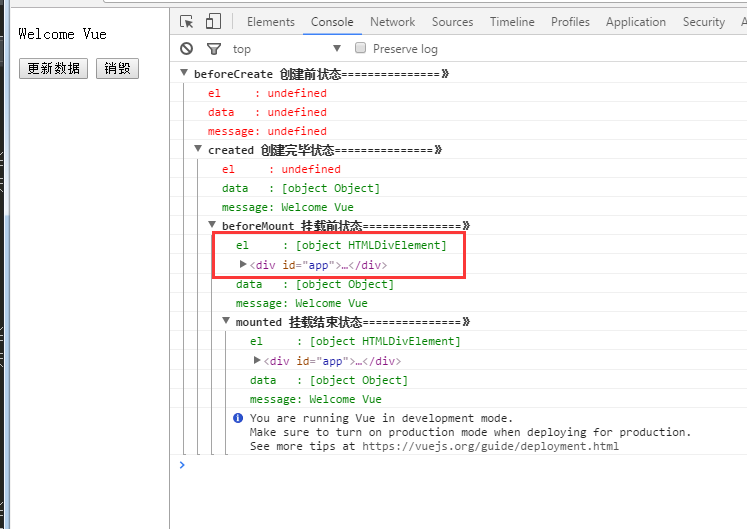Vue是现在的热门前端框架之一,采用了虚拟dom,稍微介绍一下虚拟dom的概念。在使用原生js的时候,我们总是需要去获取dom元素,这样的话,每次要获取元素都要操作一次dom,我们就要执行一次,那么我们就要考虑如何减少操作的次数,虚拟dom就是为这个考虑而设计的。
先简单介绍几个钩子函数,因为现在已经跟新到了vue2.0,因此,将主要介绍vue2.0的。
beforeCreated:我们在用Vue时都要进行实例化,因此,该函数就是在Vue实例化时调用,也可以将它理解为初始化函数比较方便一点,在Vue1.0时,这个函数的名字就是init。
created:在创建实例之后进行调用。
mounted:我们可以将他理解为原生js中的window.onload=function({.,.}),或许大家也在用jquery,所以也可以理解为jquery中的$(document).ready(function(){….}),相信讲解了这两个例子,也就理解了这个函数的功能了,他的功能就是:在dom文档渲染完毕之后将要执行的函数,该函数在Vue1.0版本中名字为compiled。
beforeDestroy:该函数将在销毁实例前进行调用
destroyed:改函数将在销毁实例时进行调用
钩子就好像是把人的出生到死亡分成一个个阶段,你肯定是在出生阶段起名字,而不会在成年或者死亡的阶段去起名字。或者说你想在出生阶段去约炮,也是不行的。组件也是一样,每个阶段它的内部构造是不一样的。所以一般特定的钩子做特定的事,比如ajax获取数据就可以在mounted阶段。
一、vue生命周期简介


咱们从上图可以很明显的看出现在vue2.0都包括了哪些生命周期的函数了,总结一下,对官方文档的那张图简化一下,就得到了这张图。

一般的执行顺序(从上往下):
beforeCreate
在实例初始化之后,数据观测(data observer) 和 event/watcher 事件配置之前被调用。
created
实例已经创建完成之后被调用。在这一步,实例已完成以下的配置:数据观测(data observer),属性和方法的运算, watch/event 事件回调。然而,挂载阶段还没开始,$el 属性目前不可见。
beforeMount
在挂载开始之前被调用:相关的 render 函数首次被调用。
mounted
el 被新创建的 vm.$el 替换,并挂载到实例上去之后调用该钩子。如果 root 实例挂载了一个文档内元素,当 mounted 被调用时 vm.$el 也在文档内。
beforeUpdate
数据更新时调用,发生在虚拟 DOM 重新渲染和打补丁之前。 你可以在这个钩子中进一步地更改状态,这不会触发附加的重渲染过程。
updated
由于数据更改导致的虚拟 DOM 重新渲染和打补丁,在这之后会调用该钩子。
当这个钩子被调用时,组件 DOM 已经更新,所以你现在可以执行依赖于 DOM 的操作。然而在大多数情况下,你应该避免在此期间更改状态,因为这可能会导致更新无限循环。
该钩子在服务器端渲染期间不被调用。
beforeDestroy
实例销毁之前调用。在这一步,实例仍然完全可用。
destroyed
Vue 实例销毁后调用。调用后,Vue 实例指示的所有东西都会解绑定,所有的事件监听器会被移除,所有的子实例也会被销毁。 该钩子在服务器端渲染期间不被调用。
二、生命周期探究
对于执行顺序和什么时候执行,看上面图基本有个了解了。下面我们将结合代码去看看钩子函数的执行。
<!DOCTYPE html>
<html>
<head>
<title>钩子函数</title>
<script type="text/javascript" src="vue_2.2.4.js"></script>
<body>
<div id="app">
<p>{{ message }}</p>
<input type="button" @click="change" value="更新数据" />
<input type="button" @click="destroy" value="销毁" />
</div>
<script type="text/javascript">
var vm = new Vue({
el: '#app',
data: {
message : "Welcome Vue"
},
methods:{
change() {
this.message = 'Datura is me';
},
destroy() {
vm.$destroy();
}
},
beforeCreate: function () {
console.group('beforeCreate 创建前状态===============》');
console.log("%c%s", "color:red","el : " + this.$el); //undefined
console.log("%c%s", "color:red","data : " + this.$data); //undefined
console.log("%c%s", "color:red","message: " + this.message);//undefined
},
created: function () {
console.group('created 创建完毕状态===============》');
console.log("%c%s", "color:red","el : " + this.$el); //undefined
console.log("%c%s", "color:green","data : " + this.$data); //[object Object] => 已被初始化
console.log("%c%s", "color:green","message: " + this.message); //Welcome Vue => 已被初始化
},
beforeMount: function () {
console.group('beforeMount 挂载前状态===============》');
console.log("%c%s", "color:green","el : " + (this.$el)); //已被初始化
console.log(this.$el); // 当前挂在的元素
console.log("%c%s", "color:green","data : " + this.$data); //已被初始化
console.log("%c%s", "color:green","message: " + this.message); //已被初始化
},
mounted: function () {
console.group('mounted 挂载结束状态===============》');
console.log("%c%s", "color:green","el : " + this.$el); //已被初始化
console.log(this.$el);
console.log("%c%s", "color:green","data : " + this.$data); //已被初始化
console.log("%c%s", "color:green","message: " + this.message); //已被初始化
},
beforeUpdate: function () {
alert("更新前状态");
console.group('beforeUpdate 更新前状态===============》'); //这里指的是页面渲染新数据之前
console.log("%c%s", "color:green","el : " + this.$el);
console.log(this.$el);
console.log("%c%s", "color:green","data : " + this.$data);
console.log("%c%s", "color:green","message: " + this.message);
alert("更新前状态2");
},
updated: function () {
console.group('updated 更新完成状态===============》');
console.log("%c%s", "color:green","el : " + this.$el);
console.log(this.$el);
console.log("%c%s", "color:green","data : " + this.$data);
console.log("%c%s", "color:green","message: " + this.message);
},
beforeDestroy: function () {
console.group('beforeDestroy 销毁前状态===============》');
console.log("%c%s", "color:red","el : " + this.$el);
console.log(this.$el);
console.log("%c%s", "color:red","data : " + this.$data);
console.log("%c%s", "color:red","message: " + this.message);
},
destroyed: function () {
console.group('destroyed 销毁完成状态===============》');
console.log("%c%s", "color:red","el : " + this.$el);
console.log(this.$el);
console.log("%c%s", "color:red","data : " + this.$data);
console.log("%c%s", "color:red","message: " + this.message)
}
})
</script>
</body>
</html>1. create 和 mounted
beforecreated:el 和 data 并未初始化
created:完成了 data 数据的初始化,el没有
beforeMount:完成了 el 和 data 初始化
mounted :完成挂载另外在标红处,我们能发现el还是 {{message}},这里就是应用的 Virtual DOM(虚拟Dom)技术,先把坑占住了。到后面mounted挂载的时候再把值渲染进去

2. update
我们单击页面中的“更新数据”按钮,将数据更新。下面就能看到data里的值被修改后,将会触发update的操作。
ps:注意beforeUpdate是指view层的数据变化前,不是data中的数据改变前触发。因为Vue是数据驱动的。注意观察弹窗就容易发现。

3. destroy
销毁完成后,我们再重新改变message的值,vue不再对此动作进行响应了。但是原先生成的dom元素还存在,可以这么理解,执行了destroy操作,后续就不再受vue控制了。因为这个Vue实例已经不存在了。
我们单击页面中的“销毁”按钮,将指定的Vue实例销毁。

三、生命周期总结
beforecreate : 举个栗子:可以在这加个loading事件
created :在这结束loading,还做一些初始化,实现函数自执行
mounted : 在这发起后端请求,拿回数据,配合路由钩子做一些事情
beforeDestory: 你确认删除XX吗? destoryed :当前组件已被删除,清空相关内容
文章评论(0)